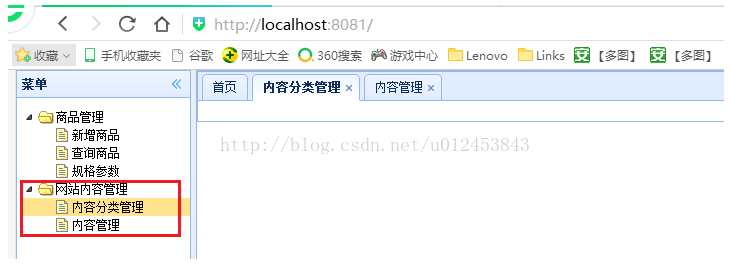本文共 14898 字,大约阅读时间需要 49 分钟。
上节课我们一起搭建了内容服务工程,这节课我们一起学习如何添加内容分类。
我们到后台管理页面看看关于内容管理的内容,如下图所示。
我们再来看下content-category.jsp页面,这个页面就是内容分类页面,页面中<ul id="contentCategory" class="easyui-tree">用来展示内容分类树,$(function()是在页面加载完后要调用的js,下面这段代码是用来获取分类列表数据的,发起的url请求是/content/category/list,animate:true的意思是设置动画,如果设置为true,展开树形结构时是慢慢展开的效果。如果设置为false展开树形结构就一下子展开了。method:"GET"指定发起的是GET请求。
- $("#contentCategory").tree({
- url : '/content/category/list',
- animate: true,
- method : "GET",
在com.taotao.content.service包下新建接口类ContentCategoryService.java,在接口类中添加一个接口getContentCategoryList。
返回值是EasyUITreeNode的集合,EasyUITreeNode类的内容如下所示。id是树节点的id,text是节点的名称,state是指树形是闭合的还是打开的,如果当前节点还有子节点,那么state的值是"closed",如果当前节点已经是叶子节点了,那么state的值是"open"。
下面我们实现上面的接口,我们在taotao-content-service的com.taotao.content.service.impl包下新建ContentCategoryServiceImpl实现类,该类实现ContentCategoryService接口类。如下图所示。
为方便复制,实现类代码如下:
- package com.taotao.content.service.impl;
- import java.util.ArrayList;
- import java.util.List;
- import org.springframework.beans.factory.annotation.Autowired;
- import org.springframework.stereotype.Service;
- import com.taotao.common.pojo.EasyUITreeNode;
- import com.taotao.content.service.ContentCategoryService;
- import com.taotao.mapper.TbContentCategoryMapper;
- import com.taotao.pojo.TbContentCategory;
- import com.taotao.pojo.TbContentCategoryExample;
- import com.taotao.pojo.TbContentCategoryExample.Criteria;
- @Service
- public class ContentCategoryServiceImpl implements ContentCategoryService {
- @Autowired
- private TbContentCategoryMapper contentCategoryMapper;
- @Override
- public List<EasyUITreeNode> getContentCategoryList(long parentId) {
- //创建一个查询类
- TbContentCategoryExample contentCategoryExample = new TbContentCategoryExample();
- //设置查询条件
- Criteria criteria = contentCategoryExample.createCriteria();
- criteria.andParentIdEqualTo(parentId);
- //查询
- List<TbContentCategory> categoryList = contentCategoryMapper.selectByExample(contentCategoryExample);
- //将categoryList转换为List<EasyUITreeNode>
- List<EasyUITreeNode> resultList = new ArrayList<>();
- for(TbContentCategory contentCategory : categoryList){
- EasyUITreeNode easyUITreeNode = new EasyUITreeNode();
- easyUITreeNode.setId(contentCategory.getId());
- easyUITreeNode.setText(contentCategory.getName());
- easyUITreeNode.setState(contentCategory.getIsParent() ? "closed":"open");
- resultList.add(easyUITreeNode);
- }
- return resultList;
- }
- }
下面我们需要在taotao-manager-web工程添加Controller类来实现内容分类展示,前提是我们需要先添加对taotao-content-interface的依赖,如下图所示。
接着我们需要在taotao-manager-web的springmvc.xml中添加对ContentCategoryService的引用,添加的内容:<dubbo:reference interface="com.taotao.content.service.ContentCategoryService" id="contentCategoryService" />,如下图所示。
下面我们在ContentCategoryController类中调用服务接口。@RequestMapping("/content/category/list")的url是从content-category.jsp当中粘贴过来的。
代码如下,这里需要注意的是,第一次查询内容分类的时候没有参数的,因此需要指定一个默认值0,后续点击要展开某个节点的话,就会把节点id传过来了。还有就是参数parentId与id名称不一致,因此需要@RequestParam(name="id",defaultValue="0")这样来把id的值赋值给"parentId"。
- package com.taotao.controller;
- import java.util.List;
- import org.springframework.beans.factory.annotation.Autowired;
- import org.springframework.stereotype.Controller;
- import org.springframework.web.bind.annotation.RequestMapping;
- import org.springframework.web.bind.annotation.RequestParam;
- import org.springframework.web.bind.annotation.ResponseBody;
- import com.taotao.common.pojo.EasyUITreeNode;
- import com.taotao.content.service.ContentCategoryService;
- @Controller
- public class ContentCategoryController {
- @Autowired
- private ContentCategoryService contentCategoryService;
- @RequestMapping("/content/category/list")
- @ResponseBody
- public List<EasyUITreeNode> getContentCategoryList(@RequestParam(name="id",defaultValue="0") Long parentId){
- List<EasyUITreeNode> list = contentCategoryService.getContentCategoryList(parentId);
- return list;
- }
- }
由于查询内容分类列表涉及到了两个服务和taotao-manager-web,因此需要启动taotao-manager服务和taotao-content服务和taotao-manager-web。
在启动之前先打包taotao-manager和taotao-content到本地maven仓库,然后依次启动taotao-manager和taotao-content,然后是taotao-manager-web,启动好之后我们访问后台,如下图所示,发现可以正常显示内容分类列表了。
分类列表展示出来了,我们下面要做的便是管理内容分类,比如增加、重命名、删除等操作,这些操作可以在某个节点上右键,在右键菜单中操作(当然,现在还没有实现这三个功能),如下图所示。
右键菜单是在content-category.jsp页面的一个<div>中定义的,如下图所示。onContextMenu: function(e,node){这行代码的意思是当我们鼠标点击右键的时候触发该js方法,方法的参数中"e"代表事件,node代表鼠标在哪个节点上。e.preventDefault();代表事件传递,$(this).tree('select',node.target);这行代码的意思是$(this)指定鼠标所在的节点转变为jquery对象,.tree('select',node.target);意思是选中这个节点(node这行会添加背景颜色)。$('#contentCategoryMenu').menu('show',{这行代码的意思是让右键菜单显示出来,下面的left和top是指坐标。
对节点进行操作的流程是,当我们点击右键菜单中的任何一个操作的时候,data-options="onClick:menuHandler"告诉我们它会触发menuHandler方法。function menuHandler(item)这行代码的意思是定义menuHandler方法,参数item是指右键菜单这个对象,下面通过item.name来判断用户选择的是哪个操作。var tree = $("#contentCategory");这行代码当然就是获取分类树了,var node = tree.tree("getSelected");这行代码是获取选中的节点,tree.tree('append', {这行代码的意思是我们点击"添加"的时候会在这个节点下面追加一个节点,parent: (node?node.target:null),是为新节点指定父节点,data里面的text是指新建的节点名称叫"新建分类",id:0,表示新建的节点暂时定义id为0,parentId:node.id是指新建节点的parentId是我们操作的节点。var _node = tree.tree('find',0);的意思是在树种找到id为0的节点(由于新建的节点暂时定义id为0,因此会找到刚添加的节点),tree.tree("select",_node.target).tree('beginEdit',_node.target);这行代码的意思是让新建的节点处于可编辑状态。可以看到实际添加节点的操作不在menuHandler这个方法中,这个方法真正执行的操作是删除节点,$.post("/content/category/delete/",{parentId:node.parentId,id:node.id},function(){这行代码的意思便是去发起url为"/content/category/delete/"的请求,传递的参数是父级id和要删除的节点的id。function()是指回调函数,tree.tree("remove",node.target);意思就是从树形结构中删掉这个节点。
那么,实际进行添加节点到数据库的操作是在哪儿控制的呢?如下图所示,onAfterEdit : function(node){意思很明显了,就是我们编辑完之后鼠标离开编辑节点后触发的事件,参数node是指新建的节点,var _tree = $(this);是指得到tree,if(node.id == 0){的意思是如果node的id是0,(我们新建的节点id就暂时是0,因此会进入这个if当中),$.post("/content/category/create"的意思是添加节点会去请求"/content/category/create"这个url。{parentId:node.parentId,name:node.text}是指传递的参数有两个,分别是父级id和节点的名称。function(data)是回调函数,data是返回的对象。if(data.status == 200){很显然是指操作成功。_tree.tree("update",{target : node.target,id : data.data.id});的意思是如果操作成功了,那么就要去更新一下新添加的节点的id,data.data.id是指添加到数据库中的节点的Id。如果if(node.id == 0)条件不成立,说明不是添加新节点操作,而是更新节点操作。$.post("/content/category/update",{id:node.id,name:node.text});意思是请求url为"/content/category/update",传递的参数有节点id、节点名称。
分析完了js代码,下面我们便来一一实现内容分类的添加、修改、删除功能
首先是添加功能,由于都是单表操作,因此使用逆向工程生成的代码就可以满足要求,我们直接修改服务层即可,我们到taotao-content-interface工程添加一个接口,如下图所示。
下面我们到taotao-content-service工程中去实现这个接口,不过在此之前,由于逆向工程自动生成的insert方法不会自动帮我们给主键的值赋值,因此我们需要在mapper.xml文件中新增一段sql,id取值为"saveAndGetId",这段sql的意思是保存内容分类并且自动给对象的id属性赋值,之所以这样做是因为我们需要用到这个id给树形结构中新增加的节点id赋值,<selectKey keyProperty="id" resultType="long" order="AFTER">就是给新添加的对象的主键赋值的,如下图所示。
为方便复制,现粘贴如下
- <insert id="saveAndGetId" parameterType="com.taotao.pojo.TbContentCategory"
- useGeneratedKeys="true" keyProperty="id">
- insert into tb_content_category (parent_id, name, status, sort_order, is_parent, created, updated)
- values (#{parentId,jdbcType=BIGINT}, #{name,jdbcType=VARCHAR},
- #{status,jdbcType=INTEGER}, #{sortOrder,jdbcType=INTEGER}, #{isParent,jdbcType=BIT},
- #{created,jdbcType=TIMESTAMP}, #{updated,jdbcType=TIMESTAMP})
- <selectKey keyProperty="id" resultType="long" order="AFTER">
- SELECT LAST_INSERT_ID()
- </selectKey>
- </insert>
做好以上准备后,我们到ContentCategoryServiceImpl类中实现添加内容分类接口了,如下所示。
实现类代码如下
- @Override
- public TaotaoResult addContentCategory(long parentId, String name) {
- //实例化一个对象
- TbContentCategory contentCategory = new TbContentCategory();
- //填充属性值
- contentCategory.setParentId(parentId);
- contentCategory.setName(name);
- //状态。可选值:1(正常),2(删除),刚添加的节点肯定是正常的
- contentCategory.setStatus(1);
- //刚添加的节点肯定不是父节点
- contentCategory.setIsParent(false);
- //数据库中现在默认的都是1,所以这里我们也写成1
- contentCategory.setSortOrder(1);
- //保存当前操作时间
- contentCategory.setCreated(new Date());
- contentCategory.setUpdated(new Date());
- //插入节点到数据库
- contentCategoryMapper.saveAndGetId(contentCategory);
- //添加一个节点需要判断父节点是不是叶子节点,如果父节点是叶子节点的话,
- //需要改成父节点状态
- TbContentCategory parent = contentCategoryMapper.selectByPrimaryKey(parentId);
- if(!parent.getIsParent()){
- parent.setIsParent(true);
- contentCategoryMapper.updateByPrimaryKey(parent);
- }
- return TaotaoResult.ok(contentCategory);
- }
服务层写完后,我们再写Controller层,我们到taotao-manager-web工程的ContentCategoryController.java当中添加Controller方法,如下图所示。
由于taotao-manager-dao工程和taotao-content工程都做了修改,因此我们重新打包taotao-manager-dao和taotao-content工程,然后重启taotao-manager、taotao-content和taotao-manager-web工程。重启后,我们到后台管理系统去增加两个分类,如下图所示,完全正确。
做完了内容分类添加,下面我们实现以下内容分类修改和删除,其中我们需要先修改下content-category.jsp页面的删除请求的参数,因为树形结构的节点只有id、name、sate三个属性,并没有parentId属性,只有新增的节点给parentId赋值了,对于页面刚加载完的树形目录,节点是没有parentId属性的,因此我们把parentId这个参数去掉,我们只通过节点id便可以删除节点了。删除parentId参数后变为"$.post("/content/category/delete/",{id:node.id},function(){"
下面我们到taotao-content-interface添加两个接口,分别是修改分类和删除分类接口,如下图所示。
接口类代码如下:
- package com.taotao.content.service;
- import java.util.List;
- import com.taotao.common.pojo.EasyUITreeNode;
- import com.taotao.common.pojo.TaotaoResult;
- public interface ContentCategoryService {
- //获取内容分类列表
- List<EasyUITreeNode> getContentCategoryList(long parentId);
- //添加内容分类,注意参数名称要与content-category.jsp页面指定的参数名称一致
- TaotaoResult addContentCategory(long parentId,String name);
- //修改内容分类,注意参数名称要与content-category.jsp页面指定的参数名称一致
- TaotaoResult updateContentCategory(long id,String name);
- //删除内容分类,注意参数名称要与content-category.jsp页面指定的参数名称一致
- TaotaoResult deleteContentCategory(long id);
- }
接着,我们到taotao-content-service来实现这两个接口,ContentCategoryServiceImpl全部代码如下所示。
- package com.taotao.content.service.impl;
- import java.util.ArrayList;
- import java.util.Date;
- import java.util.List;
- import org.springframework.beans.factory.annotation.Autowired;
- import org.springframework.stereotype.Service;
- import com.taotao.common.pojo.EasyUITreeNode;
- import com.taotao.common.pojo.TaotaoResult;
- import com.taotao.content.service.ContentCategoryService;
- import com.taotao.mapper.TbContentCategoryMapper;
- import com.taotao.pojo.TbContentCategory;
- import com.taotao.pojo.TbContentCategoryExample;
- import com.taotao.pojo.TbContentCategoryExample.Criteria;
- @Service
- public class ContentCategoryServiceImpl implements ContentCategoryService {
- @Autowired
- private TbContentCategoryMapper contentCategoryMapper;
- @Override
- public List<EasyUITreeNode> getContentCategoryList(long parentId) {
- //创建一个查询类
- TbContentCategoryExample contentCategoryExample = new TbContentCategoryExample();
- //设置查询条件
- Criteria criteria = contentCategoryExample.createCriteria();
- criteria.andParentIdEqualTo(parentId);
- //查询
- List<TbContentCategory> categoryList = contentCategoryMapper.selectByExample(contentCategoryExample);
- //将categoryList转换为List<EasyUITreeNode>
- List<EasyUITreeNode> resultList = new ArrayList<>();
- for(TbContentCategory contentCategory : categoryList){
- EasyUITreeNode easyUITreeNode = new EasyUITreeNode();
- easyUITreeNode.setId(contentCategory.getId());
- easyUITreeNode.setText(contentCategory.getName());
- easyUITreeNode.setState(contentCategory.getIsParent() ? "closed":"open");
- resultList.add(easyUITreeNode);
- }
- return resultList;
- }
- @Override
- public TaotaoResult addContentCategory(long parentId, String name) {
- //实例化一个对象
- TbContentCategory contentCategory = new TbContentCategory();
- //填充属性值
- contentCategory.setParentId(parentId);
- contentCategory.setName(name);
- //状态。可选值:1(正常),2(删除),刚添加的节点肯定是正常的
- contentCategory.setStatus(1);
- //刚添加的节点肯定不是父节点
- contentCategory.setIsParent(false);
- //数据库中现在默认的都是1,所以这里我们也写成1
- contentCategory.setSortOrder(1);
- //保存当前操作时间
- contentCategory.setCreated(new Date());
- contentCategory.setUpdated(new Date());
- //插入节点到数据库
- contentCategoryMapper.saveAndGetId(contentCategory);
- //添加一个节点需要判断父节点是不是叶子节点,如果父节点是叶子节点的话,
- //需要改成父节点状态
- TbContentCategory parent = contentCategoryMapper.selectByPrimaryKey(parentId);
- if(!parent.getIsParent()){
- parent.setIsParent(true);
- contentCategoryMapper.updateByPrimaryKey(parent);
- }
- return TaotaoResult.ok(contentCategory);
- }
- @Override
- public TaotaoResult updateContentCategory(long id, String name) {
- //通过id查询节点对象
- TbContentCategory contentCategory = contentCategoryMapper.selectByPrimaryKey(id);
- //判断新的name值与原来的值是否相同,如果相同则不用更新
- if(name != null && name.equals(contentCategory.getName())){
- return TaotaoResult.ok();
- }
- contentCategory.setName(name);
- //设置更新时间
- contentCategory.setUpdated(new Date());
- //更新数据库
- contentCategoryMapper.updateByPrimaryKey(contentCategory);
- //返回结果
- return TaotaoResult.ok();
- }
- //通过父节点id来查询所有子节点,这是抽离出来的公共方法
- private List<TbContentCategory> getContentCategoryListByParentId(long parentId){
- TbContentCategoryExample example = new TbContentCategoryExample();
- Criteria criteria = example.createCriteria();
- criteria.andParentIdEqualTo(parentId);
- List<TbContentCategory> list = contentCategoryMapper.selectByExample(example);
- return list;
- }
- //递归删除节点
- private void deleteNode(long parentId){
- List<TbContentCategory> list = getContentCategoryListByParentId(parentId);
- for(TbContentCategory contentCategory : list){
- contentCategory.setStatus(2);
- contentCategoryMapper.updateByPrimaryKey(contentCategory);
- if(contentCategory.getIsParent()){
- deleteNode(contentCategory.getId());
- }
- }
- }
- @Override
- public TaotaoResult deleteContentCategory(long id) {
- //删除分类,就是改节点的状态为2
- TbContentCategory contentCategory = contentCategoryMapper.selectByPrimaryKey(id);
- //状态。可选值:1(正常),2(删除)
- contentCategory.setStatus(2);
- contentCategoryMapper.updateByPrimaryKey(contentCategory);
- //我们还需要判断一下要删除的这个节点是否是父节点,如果是父节点,那么就级联
- //删除这个父节点下的所有子节点(采用递归的方式删除)
- if(contentCategory.getIsParent()){
- deleteNode(contentCategory.getId());
- }
- //需要判断父节点当前还有没有子节点,如果有子节点就不用做修改
- //如果父节点没有子节点了,那么要修改父节点的isParent属性为false即变为叶子节点
- TbContentCategory parent = contentCategoryMapper.selectByPrimaryKey(contentCategory.getParentId());
- List<TbContentCategory> list = getContentCategoryListByParentId(parent.getId());
- //判断父节点是否有子节点是判断这个父节点下的所有子节点的状态,如果状态都是2就说明
- //没有子节点了,否则就是有子节点。
- boolean flag = false;
- for(TbContentCategory tbContentCategory : list){
- if(tbContentCategory.getStatus() == 0){
- flag = true;
- break;
- }
- }
- //如果没有子节点了
- if(!flag){
- parent.setIsParent(false);
- contentCategoryMapper.updateByPrimaryKey(parent);
- }
- //返回结果
- return TaotaoResult.ok();
- }
- }
我们到ContentCategoryController暴露两个接口,如下图所示。
代码如下:
- @RequestMapping("/content/category/create")
- @ResponseBody
- public TaotaoResult addContentCategory(Long parentId,String name){
- TaotaoResult taotaoResult = contentCategoryService.addContentCategory(parentId, name);
- return taotaoResult;
- }
- @RequestMapping("/content/category/update")
- @ResponseBody
- public TaotaoResult updateContentCategory(Long id,String name){
- TaotaoResult taotaoResult = contentCategoryService.updateContentCategory(id, name);
- return taotaoResult;
- }
- @RequestMapping("/content/category/delete/")
- @ResponseBody
- public TaotaoResult deleteContentCategory(Long id){
- TaotaoResult taotaoResult = contentCategoryService.deleteContentCategory(id);
- return taotaoResult;
- }
代码写完了,我们重新打包taotao-content工程,然后重启taotao-content工程和taotao-manager-web工程。增加、修改、删除就都好使了。






















